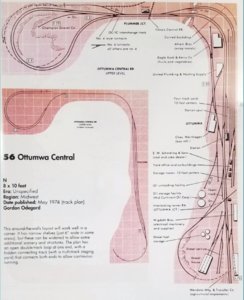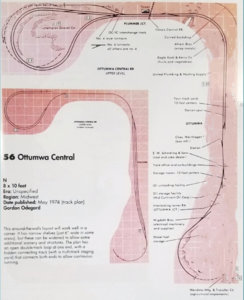Question for you guys, especially those experienced in building layouts. I found the perfect track layout for my goals running a layout. However, I've not built a layout before and this one isn't a basement empire, but it is pretty large for someone who hasn't built one before and it also would need to be built in modules so I can get it out of my current room when the time comes. I was thinking about starting smaller with this classic guide:http://users.iafrica.com/c/ca/caroper/tutorial/index.tmp as a way to easy into it, but now I keep going back and forth between using code 50 or 83 track. Should I do the smaller one? Will it be interesting enough? Should I plan on reusing the track from the small one on the big one? Should I just chalk the little one up to a learning experience and do the big one from scratch?
These are all of the questions going through my head. What would you guys do? Start with the small one or the big one? The big one is two walls of a room big, it's not THAT big, but not having built a layout I'm afraid my skills won't be up to the task and that it won't hold my interest. At the same time, I don't want to waste a bunch of money on the small one that I can't do anything with when I'm done. What do you guys think? What would you do? I've attached a picture of the big one, too, FWIW. I'm looking for a continuous run along with a little yard work and some industrial switching. Both of these layouts provide those, but to a much smaller degree on the smaller layout, of course. FWIW, other than that double reverse loop on the big one (which I will probably seek to eliminate somehow), I'm very comfortable with wiring and electronics (I work in IT, it's the most natural part of the hobby for me). I'm more worried about biting off more than I can chew with the big layout my first time around. However, it is the layout that I really want and I feel like I'd be wasting time with the smaller one.
Sorry this is so long. Thanks, everyone!
Brandon
https://www.facebook.com/photo.php?fbid=10160400363670573&set=gm.2158887284390782&type=3&ifg=1
These are all of the questions going through my head. What would you guys do? Start with the small one or the big one? The big one is two walls of a room big, it's not THAT big, but not having built a layout I'm afraid my skills won't be up to the task and that it won't hold my interest. At the same time, I don't want to waste a bunch of money on the small one that I can't do anything with when I'm done. What do you guys think? What would you do? I've attached a picture of the big one, too, FWIW. I'm looking for a continuous run along with a little yard work and some industrial switching. Both of these layouts provide those, but to a much smaller degree on the smaller layout, of course. FWIW, other than that double reverse loop on the big one (which I will probably seek to eliminate somehow), I'm very comfortable with wiring and electronics (I work in IT, it's the most natural part of the hobby for me). I'm more worried about biting off more than I can chew with the big layout my first time around. However, it is the layout that I really want and I feel like I'd be wasting time with the smaller one.
Sorry this is so long. Thanks, everyone!
Brandon
https://www.facebook.com/photo.php?fbid=10160400363670573&set=gm.2158887284390782&type=3&ifg=1



